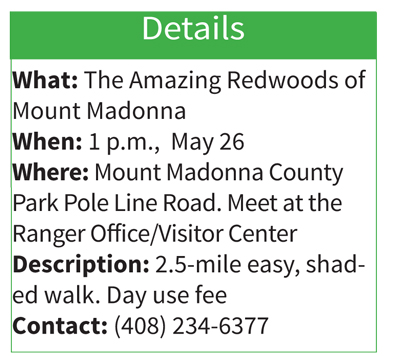Published in the May 23 – June 5, 2018 issue of Morgan Hill Life

Join Mike Monroe on a hike through Mount Madonna County Park.
There’s lots of news concerning our southern Santa Clara County Parks. Mount Madonna is in the spotlight with a couple of significant proposals by SCCP planners. A new master plan document has been announced which may lead to some expanded camping opportunities and the possibility of a new visitor center. Of more interest to me, and of more long-term importance, is the start of a vital effort to evaluate the health of the Mount Madonna forest.
Prior to the Gold Rush, the forests of southern Santa Cruz Mountains were virtually untouched by man. The Ohlone Indians did not cut down large trees, instead they likely harvested bark for shelter or hollowed out fallen trees for rafts. It was not until the arrival of Americans that the first consistent lumber operations were established. My research suggests the Murphy family had the first rudimentary mill. It was in an area known as Murphy’s Canyon in deep recesses of today’s Redwood Retreat along Little Arthur Creek.
 An early lumber mill was established by George Bodfish in 1853 with the help of his brother Orlando. In 1867, the Bodfish Mill was purchased by William Hanna and he, with his partner William Furlong, added a finishing and shingle mill on Church Street in Gilroy. Their lumber yard extended for an entire city block. Today, Wheeler Auditorium and the police department parking lot sit on a section of the Hanna yard.
An early lumber mill was established by George Bodfish in 1853 with the help of his brother Orlando. In 1867, the Bodfish Mill was purchased by William Hanna and he, with his partner William Furlong, added a finishing and shingle mill on Church Street in Gilroy. Their lumber yard extended for an entire city block. Today, Wheeler Auditorium and the police department parking lot sit on a section of the Hanna yard.
After the fever of the Gold Rush subsided and the Civil War ended in 1865, the little community of Gilroy began to grow with new homes and business typically built from old growth redwood.
In 1871, Hanna sold his lumber business to the partnership of Whitehurst and Hodges. Today’s Whitehurst Road leads up to their long-forgotten logging operation. A 1905 story in the Gilroy Advocate recalled that during the lumbering season “30 men are employed using three teams of eight horses to haul sections of cut redwoods to town. It is an interesting sight to watch the six yoke of oxen, some of which weigh a ton each, coming down the skid road with a long string of logs, chained together.
The giant logs are rolled into place and quickly the two big buzz-saws convert them into rough cut boards ready for shipment.”
The actual felling of the giant trees occurred during the dry season after a redwood section had been surveyed. During the wet wintertime, loggers usually worked making shingles and grape stakes.
Then the cutting of redwoods began with the loggers precisely felling the trees so they would land uphill and upon a prepared bed of boughs to prevent the trees from shattering. The bark and branches were removed, the logs cut into sections and hauled away and then the area set afire. Today, there are only two first growth trees remaining at Mount Madonna.
Henry Miller began acquiring Mount Madonna land from Hiram Wentworth in 1875 and he probably allowed some logging to continue, especially after the San Francisco Earthquake of 1906. Miller was cautious about fire as the forest began to regrow though. He placed the cook house away from his bungalows and made sure there was an adequate water supply on hand.
There have been recent forest fires in the area — the Whitehurst, Croy and Loma fires all come to mind. Yet much of Mount Madonna has been spared a severe blaze through active fire-fighting efforts. Fire suppression is a two-edged sword, though. As we walk the trails of Mount Madonna and the roads set out by Henry Miller and the loggers before him, we will see abundant evidence that the forest needs restoration in order to prevent a catastrophic fire. I look forward to seeing you the Saturday of Memorial Day weekend.
Keep on sauntering!
Gilroy resident Mike Monroe is a Morgan Hill business owner and naturalist. He is a docent for Santa Clara County Parks.






